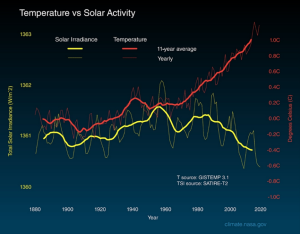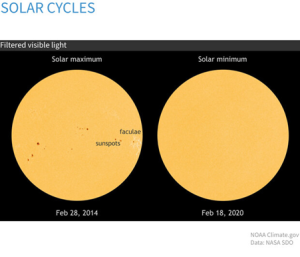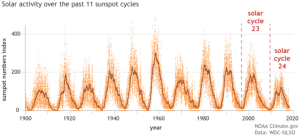6 The Sun’s Energy: Solar Cycles
The more intensely the Sun is shines on us, the warmer we get; this is also true for the planet. The intensity and distribution of solar radiation that reaches our planet varies based on solar cycles (discussed in this chapter) and orbital cycles (explained in the next chapter). In light of this, many people question whether changes in solar radiation could be responsible for global warming. NASA’s satellite data helps us answer this question.
Data collected over the past 40 years shows the Sun’s energy has decreased slightly. Yet, at the same time, Earth’s average temperature has been notably rising. [1] If the Sun were the primary reason for Earth’s warming, we wouldn’t expect solar radiation and warming to go in opposite directions. [2] To help understand why solar energy has decreased in the last few decades, we need to review the basics of solar cycles.

What Are Solar Cycles?
The Sun goes through periodic changes known as solar cycles. They can vary in length but last about 11 years on average. [3] The intensity of solar radiation reaching Earth’s surface varies during these cycles. This is because sunspots (dark areas) on the Sun’s surface will increase and decrease in number during the cycle. At the beginning of a solar cycle, the Sun has the fewest sunspots (the solar minimum). The number of sunspots peak in the middle of the cycle (the solar maximum). After the solar maximum, the number of sunspots decreases again and a new cycle begins. [4] [5]

You might think that when the Sun has more dark spots during the solar maximum, Earth will get less energy from the Sun, but surprisingly, this isn’t the case. Satellite data have shown us something entirely different. When there are more dark spots, the Sun gives off a tiny bit more energy, not less. This is because of hot, bright areas called faculae that tend to form around sunspots. [6]. This means that solar maximums are associated with a very slight increase in the energy output from the Sun compared to solar minimums.
Not all solar cycles are the same; some have more sunspots than others. At the peak of active, strong solar cycles, the extra energy that reaches the Earth from the Sun might increase by around 0.1 percent, increasing global average temperatures by 0.05-0.1 degree Celsius. [7] [8] This amount is not nearly enough to produce the around 1-degree Celsius change in temperature that has been observed. [9] [10]
Watch the video from NASA Goddard Space Flight Center. The video shows a view of the Sun from space telescopes as it transitions from a solar minimum to a solar maximum during a solar cycle.
How are Solar Cycles Connected to Global Warming?
The amount of solar energy the Earth has received from the Sun since industrialization has followed the ups and downs of the Sun’s natural solar cycles. As seen in the chart below, starting around the early 1900s, each solar cycle appeared more active than the last, peaking in 1957 during solar cycle 19. However, solar activity decreased in the second half of the 20th century. More recent cycles, such as solar cycle 23 & 24, have shown fewer sunspots compared to some previous cycles. The decrease in sunspot activity helps explain the dimming effect of the Sun during the last couple of decades. [11]

If you take into account the increase in solar activity in the first half of the 20th century, as well as the decreasing activity in the last few decades, experts think the impact on global warming is negligible; they have “largely canceled each other out in terms of their influence on global temperature.” [12]
In conclusion, data on solar cycles suggests they cannot be the leading cause of global warming. Since industrialization, we have seen over a 1-degree Celsius increase in the planet’s temperature – much more than these solar cycles could contribute. Moreover, solar cycles have been less active over the past forty years, leading to less solar radiation reaching Earth. If solar cycles were the main cause of global warming, we would expect solar activity and temperature to both increase; however, they are going in opposite directions. This evidence suggests that changes in solar activity are not the cause of climate change and that there is another cause. Scientists have determined climate change can mainly be attributed to human activities that release greenhouse gases into the atmosphere.
As mentioned earlier, solar cycles are not the only thing that affects how much solar radiation the Earth receives. Orbital cycles also play an important role. To fully comprehend what influences the Sun’s radiation intensity on Earth, it’s essential to incorporate an understanding of Earth’s orbital cycles.
- "Graphic: Temperature Vs Solar Activity." NASA, 10 Jul. 2020, climate.nasa.gov/climate_resources/189/graphic-temperature-vs-solar-activity/. Accessed 9 Jul. 2023. ↵
- "The sun and climat moving in opposite directions." Skeptical Science https://skepticalscience.com/solar-activity-sunspots-global-warming.htm. Accessed 9, Jul 2023. ↵
- "What Is the Solar Cycle?" NASA Science Space Place, spaceplace.nasa.gov/solar-cycles/en/. Accessed 29 Jun. 2023. ↵
- "What Is the Solar Cycle?" NASA Science Space Place, spaceplace.nasa.gov/solar-cycles/en/. Accessed 29 Jun. 2023. ↵
- https://www.nasa.gov/mission_pages/sunearth/solar-events-news/Does-the-Solar-Cycle-Affect-Earths-Climate.html ↵
- "Why NASA Keeps a Close Eye on the Sun's Irradiance." NASA, 25 May 2010, www.nasa.gov/topics/solarsystem/features/sun-brightness.html. Accessed 29 Jun. 2023. ↵
- McLachlan, Robert. "Climate Explained: Sunspots Do Affect Our Weather, a Bit, but Not As Much As Other Things." The Conversation, 1 Sept. 2020, theconversation.com/climate-explained-sunspots-do-affect-our-weather-a-bit-but-not-as-much-as-other-things-145101. Accessed 28 Jul. 2023. ↵
- Lindsey, Rebecca. "Climate Change: Incoming Sunlight." NOAA, 1 Sept. 2009, www.climate.gov/news-features/understanding-climate/climate-change-incoming-sunlight. Accessed 9 Jul. 2023. ↵
- Lindsey, Rebecca. "Climate Change: Incoming Sunlight." NOAA, 1 Sept. 2009, www.climate.gov/news-features/understanding-climate/climate-change-incoming-sunlight. Accessed 9 Jul. 2023. ↵
- "FAQ: How Does the Solar Cycle Affect Earth's Climate?" NASA, Updated 1 Feb. 2021, www.nasa.gov/mission_pages/sunearth/solar-events-news/Does-the-Solar-Cycle-Affect-Earths-Climate.html. Accessed 12 Jul. 2023. ↵
- Herring, David . "Couldn't the Sun Be the Cause of Global Warming?" NOAA, 29 Oct. 2020, www.climate.gov/news-features/climate-qa/couldnt-sun-be-cause-global-warming. Accessed 9 Jul. 2023. ↵
- Lindsey, Rebecca. "Climate Change: Incoming Sunlight." NOAA, 1 Sept. 2009, www.climate.gov/news-features/understanding-climate/climate-change-incoming-sunlight. Accessed 9 Jul. 2023. ↵
